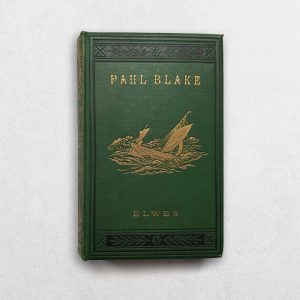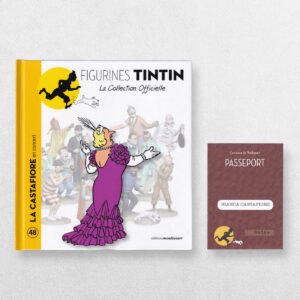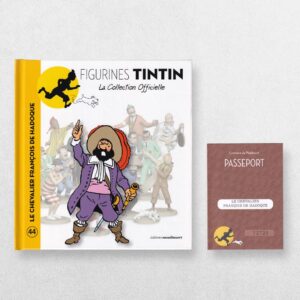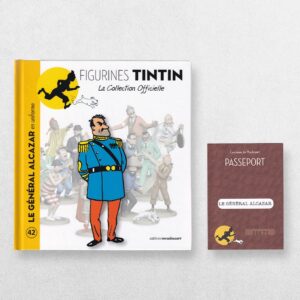Tintin In Armour – Figurines Tintin La Collection Officielle – 49 – Tintin En Armure
Hergé & Editions Moulinsart
£85.00
Availability: In stock
Product Description
Tintin In Armour – Figurines Tintin La Collection Officielle – 49 – Tintin En Armure
Author: Hergé & Editions Moulinsart
Price: £85.00
Publisher: Editions Moulinsart
Publication date: 2013
Format: Original pictorial boards with passport and figurine
Condition: In near fine condition
Illustrations: Illustrated throughout
Description:
Original pictorial boards. Includes passport loosely inserted. Text in French. Includes the accompanying figurine. One from the collection of 111 books and figurines. Very slight wear. In very near fine, clean condition overall.
Tintin In Armour: A Brief Study
The image of Tintin in armour — most famously from The Secret of the Unicorn (Le Secret de la Licorne, 1943) — is one of the most memorable visual symbols in Hergé’s universe. It captures the essence of Tintin’s character: curiosity, courage, and a touch of comic awkwardness wrapped in a spirit of adventure and discovery.
Context and Appearance
Tintin dons a suit of medieval armour during his investigation at Marlinspike Hall (Moulinsart in French) in The Secret of the Unicorn. While searching the grand old house for clues about the model ship The Unicorn — and the treasure of Sir Francis Haddock — Tintin’s curiosity leads him to explore a gallery of historical relics.
Among these is a display of full knight’s armour. Tintin, ever inquisitive, inspects it — only for the armour to topple forward, momentarily trapping him. The resulting scene, rendered with Hergé’s crisp line work and perfect comic timing, combines suspense, humour, and nostalgia.
It’s a fleeting moment, but it symbolises Tintin’s role as a modern-day knight — the descendant, in spirit, of the very chivalric ideals represented by the armour.
Symbolism
The image of Tintin in armour carries deep thematic resonance within Hergé’s storytelling:
- Chivalry and Moral Integrity:
The suit of armour recalls the medieval knightly virtues of courage, loyalty, and righteousness — qualities Tintin embodies throughout his adventures. His moral compass is unwavering; he is brave without being violent, principled without being sanctimonious. - Connection to Heritage and History:
In The Secret of the Unicorn, the armour also links Tintin to Captain Haddock’s ancestral past — the world of Sir Francis Haddock, naval officer and nobleman. Tintin’s encounter with the armour foreshadows his discovery of the Haddock family’s noble lineage and their connection to The Unicorn. - Comic Heroism:
Tintin’s brief entrapment inside the armour adds an element of self-deprecating humour. Like many of Hergé’s best moments, the scene balances grandeur and absurdity: the modern boy reporter momentarily transformed into a clumsy knight. - Timeless Adventure:
The armour represents the continuity between past and present — Tintin as the inheritor of an eternal tradition of adventure, duty, and exploration.
Artistic Analysis
Hergé’s clean, precise ligne claire (clear line) style gives the armour both realistic weight and symbolic clarity. The reflective surfaces, careful hatching, and historical accuracy reveal Hergé’s meticulous attention to detail and his love of museum-like authenticity.
Yet, even within that realism, the composition remains playful. Tintin’s wide-eyed expression and the stiff, imposing structure of the armour create a perfect visual joke. The image embodies Hergé’s genius for blending comedy with narrative insight — a still moment that deepens character rather than distracts from the story.
Broader Significance
The “Tintin in armour” motif has become emblematic of the series as a whole. It encapsulates the blend of modern curiosity and old-world adventure that defines The Adventures of Tintin.
- It situates Tintin within a European cultural lineage, connecting the 20th-century journalist to the mythic knights and explorers of earlier ages.
- It also highlights one of Hergé’s central themes: the persistence of human ideals — truth, bravery, and decency — across time.
In this sense, Tintin wearing or examining armour is not just a comic image but a symbolic portrait of the hero as timeless moral figure.
Thematic Continuities
This motif reappears metaphorically throughout Hergé’s work:
- In King Ottokar’s Sceptre, Tintin defends a monarch’s honour and sovereignty, echoing the duties of a knight.
- In The Red Sea Sharks, his defence of enslaved people echoes chivalric notions of justice and protection.
- Even in Tintin in Tibet, his loyalty to his friend Chang is a modern form of knightly devotion.
Thus, “Tintin in armour” becomes shorthand for his defining virtue — moral courage in a world that often forgets it.
Summary
- Scene: The Secret of the Unicorn (1943)
- Setting: Marlinspike Hall
- Meaning: Comic yet symbolic moment connecting Tintin’s modern heroism with the chivalric ideals of the past
- Symbolism: Courage, curiosity, heritage, and the timeless nature of integrity
- Artistic value: A perfect example of Hergé’s balance of humour, detail, and thematic resonance
Why Buy from Us?
At Hornseys, we are committed to offering items that meet the highest standards of quality and authenticity. Our collection of objects and rare books are carefully curated to ensure each edition is a valuable piece of bibliographical history. Here’s what sets us apart:
- Authenticity and Provenance: Each item is meticulously researched and verified for authenticity and collation.
- Expert Curation: Our selection process focuses on significance, condition, and rarity, resulting in a collection that is both diverse and distinguished.
- Customer Satisfaction: We aim to provide an exceptional customer experience, from detailed descriptions to secure and prompt delivery of your purchase.
- Returns Policy: We offer an unconditional guarantee on every item. If you wish to return an item, it may be sent back to us within fourteen days of receipt. Please notify us in advance if you wish to do so. The item must be returned in the same condition as it was sent for a full refund.
Cataloguer: Daniel Hornsey
Daniel Hornsey has specialised in fine and rare books, ephemera, and collectors’ editions for over thirty years. As a long-standing member of the antiquarian book trade, he has advised private collectors, curated catalogues, and sourced works for leading dealers, libraries and institutions across the world.
Hornseys’ exhibit regularly at book and map fairs in London and throughout the UK and are members of the Provincial Booksellers Fairs Association, the PBFA.
His fascination with Hergé’s work — especially ‘The Adventures of Tintin’ — began in childhood. Daniel recalls reading Tintin in original European editions and quickly recognising that these were not merely children’s books, but finely illustrated narratives crafted with artistic depth and wit.
As noted by the Musée Hergé in Louvain-la-Neuve, Hergé’s ‘ligne claire’ style has influenced generations of European comic artists and his original drawings and paintings command very high prices with his painting of ‘The Blue Lotus’ jar fetching £2.8m at auction in 2021.
By presenting these works through Hornseys’, he hopes to contribute to the continued appreciation of one of the 20th century’s most influential illustrators, helping new generations discover the artistry and legacy of Hergé.
Related products
Paul Blake Or The Story Of A Boy’s Perils In The Islands Of Corsica And Monte Cristo
£125.00Elwes, Alfred (Leighton Binding)
The Gruffalo & The Gruffalo’s Child: First Deluxe Miniature Editions Both Signed By Julia Donaldson & Axel Scheffler
£495.00Donaldson, Julia & Scheffler, Axel
Paddington Marches On With Card Signed By Michael Bond Loosely Inserted
£545.00Bond, Michael Illustrated By Fortnum, Peggy
You may also like…
Castafiore In Concert – Figurines Tintin La Collection Officielle – 48 – La Castafiore En Concert
£45.00Hergé & Editions Moulinsart
Sir Francis Haddock – Figurines Tintin La Collection Officielle – 44 – Le Chevalier François De Hadoque
£95.00Hergé & Editions Moulinsart
General Alcazar In Uniform – Figurines Tintin La Collection Officielle – 42 – Le Général Alcazar En Uniforme
£45.00Hergé & Editions Moulinsart
Colonel Sponsz Upset – Figurines Tintin La Collection Officielle – 37 – Le Colonel Sponsz Contrarié
£55.00Hergé & Editions Moulinsart
Monsieur Boullu The Stonemason – Figurines Tintin La Collection Officielle – 35 – Monsieur Boullu Le Marbrier
£40.00Hergé & Editions Moulinsart
Haddock Alpinist – Figurines Tintin La Collection Officielle – 34 – Haddock En Alpiniste
£45.00Hergé & Editions Moulinsart
Calculus The Gardener – Figurines Tintin La Collection Officielle – 28 – Tournesol En Jardinier
£35.00Hergé & Editions Moulinsart
Haddock As Hadoque – Figurines Tintin La Collection Officielle – 24 – Haddock En Hadoque
£45.00Hergé & Editions Moulinsart
Ridgewell The Explorer – Figurines Tintin La Collection Officielle – 23 – Ridgewell L’Explorateur
£45.00Hergé & Editions Moulinsart
Tintin In Kilt – Figurines Tintin La Collection Officielle – 22 – Tintin En Kilt
£65.00Hergé & Editions Moulinsart
King Muskar Puts On His Gloves – Figurines Tintin La Collection Officielle – 20 – Le Roi Muskar Enfile Ses Gants
£45.00Hergé & Editions Moulinsart
Snowy Stuck In The Crab Tin – Figurines Tintin La Collection Officielle – 19 – Milou Coincé Dans La Boîte De Crabe
£45.00Hergé & Editions Moulinsart
Nestor With The Tray – Figurines Tintin La Collection Officielle – 18 – Nestor Au Plateau
£45.00Hergé & Editions Moulinsart
Chang Points Out Hou Kou – Figurines Tintin La Collection Officielle – 8 – Tchang Indique Hou Kou
£35.00Hergé & Editions Moulinsart
Tintin In A Lunar Spacesuit – Figurines Tintin La Collection Officielle – 7 – Tintin En Scaphandre Lunaire
£55.00Hergé & Editions Moulinsart
Snowy Carries His Bone – Figurines Tintin La Collection Officielle – 6 – Milou Promène Son Os
£40.00Hergé & Editions Moulinsart
Castafiore With The Parrot – Figurines Tintin La Collection Officielle – 5 – La Castafiore Au Perroquet
£75.00Hergé & Editions Moulinsart
Thomson Looking Awkward – Figurines Tintin La Collection Officielle – 4 – Dupond Engoncé
£40.00Hergé & Editions Moulinsart
Professor Calculus With A Spade – Figurines Tintin La Collection Officielle – 3 – Tournesol A La Bêche
£40.00Hergé & Editions Moulinsart
Haddock Doubtful – Figurines Tintin La Collection Officielle – 2 – Haddock Dubitatif
£40.00Hergé & Editions Moulinsart
Tintin In Trenchcoat – Figurines Tintin La Collection Officielle – 1 – Tintin En Trench-Coat
£75.00Hergé & Editions Moulinsart



























